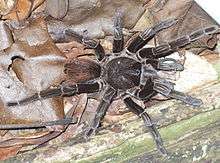Sericopelma
Sericopelma is a genus of tarantula (family Theraphosidae), found in Central America from Nicaragua to Panama. The limits of the genus and its distribution have long been confused; it is closely related to the genus Aphonopelma. Sericopelma species are among the largest found in Central America. They can be kept as pets, although at least one species has been described as "very aggressive".
| Sericopelma | |
|---|---|
 | |
| Species from Barro Colorado Island, possibly S. embrithes | |
| Scientific classification | |
| Kingdom: | Animalia |
| Phylum: | Arthropoda |
| Subphylum: | Chelicerata |
| Class: | Arachnida |
| Order: | Araneae |
| Infraorder: | Mygalomorphae |
| Family: | Theraphosidae |
| Genus: | Sericopelma Ausserer, 1875[1] |
| Synonyms[1] | |
| |
Description
Spiders in the genus Sericopelma are some of the largest found in Central America. Males have bodies 65–80 mm (2.6–3.1 in) long, females are somewhat longer at 70–100 mm (2.8–3.9 in). They can be kept as pets in terraria, although S. melanotarsum is described as "very aggressive".[2]
Characters that distinguish species of the genus Sericopelma from other theraphosids found in the same localities include the following. The carapace is longer than wide, with a deep transverse pit (fovea) and distinct grooves radiating from it. The femur of the fourth leg has a dense pad of feathery (plumose) hair on the side facing away from the head of the animal (retrolateral); the metatarsus of the same leg has a divided and reduced trace of tuft-like (scopulate) hairs at the end furthest from the body. The first leg lacks stridulatory hairs. Females have spermathecae with a single lobe, expanded at the apex to form a P-shape in cross-section. Males lack tibial spurs and their palpal bulbs have an embolus of a characteristic shape.[3]
Taxonomy
Sericopelma was initially described by Anton Ausserer in 1875 as a subgenus of Eurypelma (now Avicularia) with the type species E. rubronitens. It was given full generic status by Simon in 1892. Until the middle of the 20th century only males were known by formal descriptions. The genus as a whole was described in 2015 as "poorly defined". Confusion with genera such as Brachypelma has been frequent; two species were transferred from that genus in 2015.[3]
A molecular phylogenetic study in 2016 produced the cladogram shown below, showing that Sericopelma is embedded in the genus Aphonopelma, as the latter is currently circumscribed. It is likely that generic boundaries will change with further research.[4]
| |||||||||||||
Species
As of February 2016, the World Spider Catalog accepted the following species:[1]
- Sericopelma angustum (Valerio, 1980) – Costa Rica
- Sericopelma commune F. O. Pickard-Cambridge, 1897 – Panama
- Sericopelma dota Valerio, 1980 – Costa Rica
- Sericopelma embrithes (Chamberlin & Ivie, 1936) – Panama
- Sericopelma ferrugineum Valerio, 1980 – Costa Rica
- Sericopelma generala Valerio, 1980 – Costa Rica
- Sericopelma immensum Valerio, 1980 – Costa Rica
- Sericopelma melanotarsum Valerio, 1980 – Costa Rica
- Sericopelma panamanum (Karsch, 1880) – Panama; may be included in S. rubronitens[3]
- Sericopelma panamense (Simon, 1891) – Panama (some sources include Mexico, but this is rejected in a 2015 study[3])
- Sericopelma rubronitens Ausserer, 1875 – Central America (Panama[3])
- Sericopelma silvicola Valerio, 1980 – Costa Rica
- Sericopelma upala Valerio, 1980 – Costa Rica
One species has been rejected as a member of the genus Sericopelma, but no other placement has been given,[5][3] so that it is still listed in this genus:[1]
- Sericopelma fallax Mello-Leitão, 1923 – Brazil
Distribution
Specimens placed in the genus have been given localities ranging from Mexico to Brazil. However, detailed studies by Gabriel and Longhorn in 2011 and 2015 suggest that some of these were errors, and that the true range of the genus is from Nicaragua to Panama.[5][3]
References
- "Gen. Sericopelma Ausserer, 1875", World Spider Catalog, Natural History Museum Bern, retrieved 2016-02-15
- Schmidt, G. (2003), "Gattung Sericopelma Ausserer, 1875", Die Vogelspinnen: Eine weltweite Übersicht, Neue Brehm-Bücherei (in German), Hohenwarsleben: Westarp Wissenschaften, pp. 186–187, ISBN 978-3-89432-899-3
- Gabriel, Ray & Longhorn, Stuart J. (2015), "Revised generic placement of Brachypelma embrithes (Chamberlin & Ivie, 1936) and Brachypelma angustum Valerio, 1980, with definition of the taxonomic features for identification of female Sericopelma Ausserer, 1875 (Araneae, Theraphosidae)", ZooKeys, 526: 75–104, doi:10.3897/zookeys.526.6315, PMC 4607846, PMID 26487826
- Hamilton, C.A.; Hendrixson, B.E. & Bond, J.E. (2016), "Taxonomic revision of the tarantula genus Aphonopelma Pocock, 1901 (Araneae, Mygalomorphae, Theraphosidae) within the United States", ZooKeys, 560: 1–340, doi:10.3897/zookeys.560.6264, PMC 4768370, PMID 27006611
- Gabriel, R. & Longhorn, S.J. (2011), "Redescriptions of the holotypes of Mygalarachnae [sic] Ausserer 1871 and Harpaxictis Simon (1892) (Araneae: Theraphosidae) with rebuttal of their synonymy with Sericopelma Ausserer 1875", Revista Ibérica de Aracnología, 19: 157–165